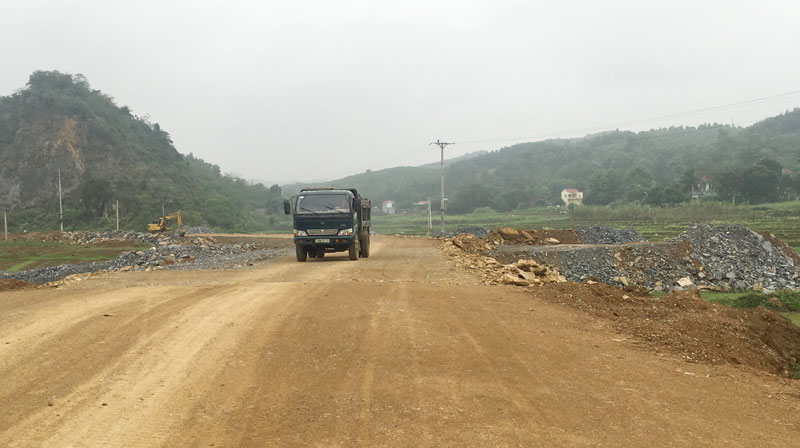
(HBO) - Among the key traffic projects invested by the Department of Transportation, the project of the connecting Ho Chi Minh Road and Highway 12B to National Highway 1 is being urged to speed up the progress.
 By the middle of June 2019, the project connecting Ho Chi
Minh Road and National Road 12B to National Highway 1 was constructed with the
total construction volume of over 37%, trying to complete and reach the set
schedule by the end of this year.
By the middle of June 2019, the project connecting Ho Chi
Minh Road and National Road 12B to National Highway 1 was constructed with the
total construction volume of over 37%, trying to complete and reach the set
schedule by the end of this year.
According to the design scale, the investment project to
build the road with a total length of about 30 km. The starting point of the
route is connected to Ho Chi Minh road at 479 + 300 km in Bao Hieu commune (Yen
Thuy), the end of the route is intersected with Highway 12B at 67 + 100 km,
belonging to Vu Ban town (Lac Son). With a total investment of 250 billion VND,
the road will be upgraded, reaching the road’s standard of grade IV - delta
(TCVN 4054 - 2005) according to the provincial master plan of transport
development. Directly connecting 3 arterial traffic axes in the province, when
completed and put into use, this road will create favorable conditions for
people and vehicles to participate in traffic, effectively contributing to the
local socio-economic development.
According to the evaluation of the Project Management Board
of the Project, by the middle of June 2019, the volume of road embankment was
about 111 thousand m3, reaching 50.23%; the volume of digging the road base was
about 341.5 thousand m3, reaching 68.3%; the volume of the completed
construction was 32/45 horizontal drainage culverts. They completed concrete
casting of decks, railings, handrails for Thuong bridge at 0 + 955.5 km, for My
bridge at 13 + 424,25 km and for Thai bridge 15 + 367.06 km and so on. Up to
now, the construction value has reached over 37% of the total construction
value of the project.
The investors and the Project Management Board have been
actively urging the contractors to focus on mobilizing the human resources, the
machinery, the equipment and materials to speed up the construction progress of
the remaining items, setting the determination to complete the project this
year.
Hoa Binh province is undergoing a dynamic transformation amid Vietnam’s national digital transition. Building on Poliburo’s Resolution No. 57-NQ/TW on breakthroughs in science, technology, innovation, and national digital transformation, the province has rolled out a wide range of practical action plans. A standout initiative is the "Digital Literacy for All” movement, an effort to ensure that no one is left behind in the digital era.
Hoa Binh province is undergoing a dynamic transformation in the wake of the national digital transformation movement. Building on Resolution No. 57-NQ/TW of the Politburo on breakthroughs in science, technology, innovation, and national digital transformation, the province has implemented a wide range of practical action plans. A standout initiative is the "Digital Literacy for All” movement ambitious effort to ensure that no one is left behind in the digital age.
With a spirit of unity and proactive problem-solving, the Party Committee, the government and the people of Dong Lai Commune (Tan Lac District) have made great strides in implementing the resolutions of the 24th Party Congress of the commune for the 2020 - 2025 term. Focusing on leadership and practical actions, the commune has brought the Party’s resolutions into daily life, creating strong impacts and pushing the local development forward.
Amid the nationwide push for digital transformation, young people in Hoa Binh Province are stepping up as dynamic pioneers, applying technology to enhance Youth Union operations and expand the reach of youth-led initiatives. Through creativity and adaptability, Youth Union organizations at all levels have introduced a series of practical solutions, contributing to modern governance and community development.
In recent years, An Nghia commune, located in Lac Son district, has stepped up administrative reform, focusing on improving the quality and efficiency of its single-window service unit for receiving and processing administrative procedures. These improvements have helped create favourable conditions for local residents and organisations to handle administrative procedures, contributing to the commune’s broader socio-economic development.
The Prime Minister-approved master plan to develop the multi-use value of forests ecosystems through 2030, with a vision to 2050, aims to improve the management and sustainable use of forest resources, create jobs, increase incomes, and improve the living standards of ethnic minorities, people in mountainous and remote areas, forest workers and those living near forests.



 By the middle of June 2019, the project connecting Ho Chi
Minh Road and National Road 12B to National Highway 1 was constructed with the
total construction volume of over 37%, trying to complete and reach the set
schedule by the end of this year.
By the middle of June 2019, the project connecting Ho Chi
Minh Road and National Road 12B to National Highway 1 was constructed with the
total construction volume of over 37%, trying to complete and reach the set
schedule by the end of this year.